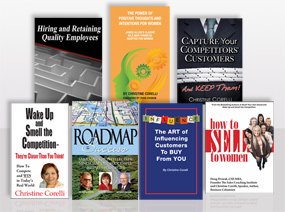![]()
With all the re-engineering, downsizing, reorganizing, take-overs, mergers acquisitions, outsourcing, and other sure-fire strategies businesses are using to survive during a tough economy, it’s time for us to realize that our human resources hold the key to sustainable, long-term growth. Employees can offer solutions to problems, methods to improve productivity, creative ideas to improve products and services, and even insight on what management needs to do to move forward. That assumes, of course, that you have a workforce of people who want to come to work every day, ready to serve you and your customers, and that you provide an environment that encourages high performance.
One of the most challenging problems facing many businesses is creating this type of environment. Often companies feel they have more important issues to attend to-especially during a tough economy. An enlightened organization cares about its people, treats them with respect, and values them as much as they value their customers. Most important, their employees know it.
It’s this type of environment that breeds “achievers”-high-performers who are dependable, accountable, competent, productive, and show initiative beyond their job description by coming forth with ideas that can help the company move forward. One way to create an environment for high performance is to learn what employees want. Here’s an effective way to make that determination. “Everyone wants job stability, fair pay and benefits. What else do you want from your employer? What, in your opinion, would improve morale.”
The following responses are compiled from research conducted from individuals in a wide variety of industries across the country.
I want to work for a company with a good culture.
An organization’s culture is the result of the attitudes, philosophy, and values demonstrated by its upper-level executives. If your organization’s culture is suffering, you must first look at management for the cause. If you have a positive culture, the same holds true. The best leaders create the type of culture where teamwork is encouraged and people work together for the common good of the organization. The culture should foster open communication, respect for others, and integrity in all business dealings. It should encourage people to perform at exceptional levels, with management’s support. Employees can become discouraged when performance expectations are high but the company does nothing to help them attain their goals. Then the company wonders why its people are not highly motivated.
I want to work for a company that’s well-managed.
Achievers become discouraged without strong leadership. Many organizations have failed because management was not in touch with the perceptions, opinions, expectations, needs, and problems of their people. Perhaps the sales reps aren’t getting the help they need, or a division isn’t delivering the level of service the company expects. There may be an employee who is slacking on the job and displaying negative behavior, thus pulling down an entire department. Be sensitive to such problem areas in your organization, and make an effort to find solutions.
I want a great boss who knows how to motivate me.
Every company should have a “Zero-Tolerance for Bad Bosses” rule. The No. 1 cause of job dissatisfaction in America is working for a bad boss. Poor leaders can pass their weaknesses to others. They can let their ego or need for power and control get in the way of doing what’s best. They may dwell on a mistake rather than discuss how to prevent it from recurring.
A bad boss also can sabotage the performance of Achievers by eroding their attitude and potential. If you have achievers whose performance has dwindled, perhaps their boss has held them back or shot down their ideas to a point where they feel no matter what they say or do, they will never make an impact. Perhaps this destructive boss gave them lip service, reprimanded them in front of others, or frustrated them by micromanaging their projects. Perhaps the boss showed favoritism or took credit for others’ ideas.
A great boss instinctively knows that the key to employee motivation is to motivate from within. In order to do that, you need to make people feel they’re working with you, not for you. If your employees feel they are working for you, then you’re creating robots-people who simply go through the motions and do what they’re told. Robots will not come forward with their ideas; they only follow orders. You’ll never inspire them to be creative and innovative, and they will never take ownership for the company’s success.
To make people feel they’re working with you, provide an open environment rather than an authoritarian atmosphere, where employees are afraid to step over the line or make suggestions. Motivating through fear kills creativity. People need to work in a positive atmosphere where they are not afraid to point out problems and suggest new ways to serve customers or improve systems and procedures. And they need to work for a leader who earns their respect by working hard and by being fair and supportive.
I want to be appreciated, recognized, and rewarded for my work.
High on the list of reasons people want to leave companies is limited recognition and praise. As Dale Carnegie said, “All human beings wear two invisible signs. One says, ‘Make me feel important.’ The other says, ‘Appreciate me.'” People need respect and approval, and to feel a sense of accomplishment.
Research tells us that giving praise consistently is one of the most effective methods of motivating people and lifting morale. Although frequent, regular praise may be the road to motivating people, employees also need to be rewarded. In the past, many employees did not put forth their best efforts, because they experienced any extra output benefited only the company’s stockholders, executives, managers, and not themselves. This is less prevalent today, but employees want to be rewarded in some way for good performance as often and as soon as possible.
Create a system for rewards that is built into the job. For example, if your goal is quality workmanship, give rewards for defect-free performance. If it is to trim overhead, reward for cost-cutting measures. Reward employees for providing exceptional service, for meeting sales objectives, and even for small efforts that make a difference. And don’t only reward individuals for exceptional performance; recognize team accomplishments as well. Learn what successful companies are doing to maintain high morale, and improve quality.
I want to have a voice in the decision-making.
Employees remain motivated when they have a high level of involvement and can participate in idea-sharing and problem-solving sessions. Establish self-directed teams or task forces to help in this area. Don’t make the mistake of asking only your achievers to partake in these sessions. All your people need to feel they play a vital role in your organization and have a voice in the decision-making process.
Here’s how an executive in a metal-working company, seeking ideas to cut overhead, received help from one of his employees. The employee pointed out that the company was using a large number of lubricant suppliers, so he found a supplier who could provide a single multipurpose lubricant for all the company’s needs. Not only did this strategy save money, it also reduced inventory costs and the quantity of oil the company had to keep in stock. What’s more, the company gained valuable storage space and reduced the paperwork necessary for purchasing and receiving.
A division of ITW estimated a cost savings of $3,000,000 as a result of their “Employee Empowerment Program.” Teams were formed with individuals on all levels and from various departments. They were challenged to come up with ideas to help the company improve safety, productivity, cut overhead, improve communication and morale. Each team selected their favorite charity. Prizes, gifts, and rewards were given to teams during the process. At year end, the team who brought the most valuable ideas to the company was awarded $10,000 to be donated to their charity, in their names.
When employees offer suggestions and recommendations for solutions, be sure to act on those ideas. Don’t be insincere by asking employees to participate in decision-making and then ignoring their input. If you decide that you can’t act on an employee’s suggestions, then honestly explain why. Whenever possible, find elements of their solutions that are viable or that you can implement in the future. Keep employees creatively charged by praising them for any ideas they offer. They need to know you appreciate their efforts.
I want to work where I can look forward to showing up every day and maybe even have some fun.
Fun in the workplace. What a novel idea! Business is very serious these days, but that doesn’t mean that we can’t have a little fun along the way. Encourage your people to use a little creativity to come up with ideas to keep the workplace interesting and fun. Do something spontaneous and out of the ordinary.
If we lived in a perfect world, our workforce would consist only of Achievers. But that’s not reality. To improve the performance of your employees, take a long, hard look at your company’s culture from their perspective. Make it company policy to focus on the health, moral, and productivity of your people. Do an employee satisfaction survey to find out what you are doing well, and what needs to improve. Identify issues, and investigate why these issues exist. Sit down with them, and together, set goals, and challenge them to reach higher. If you do these things, you will soon see them roll up their sleeves and go to work for you. When they do, you will be amazed at how this strong workforce can help carry your organization into a successful future.

